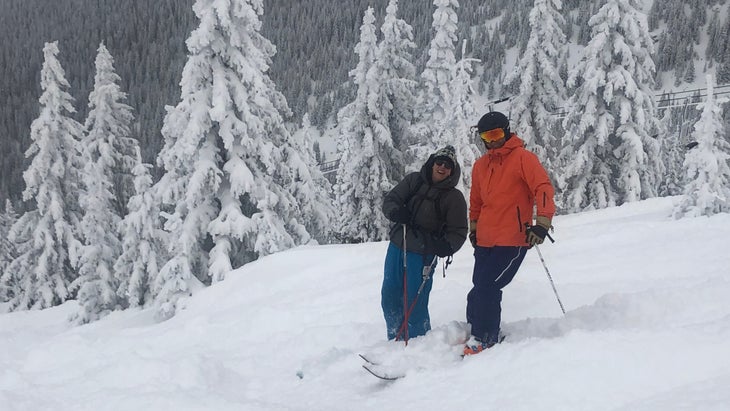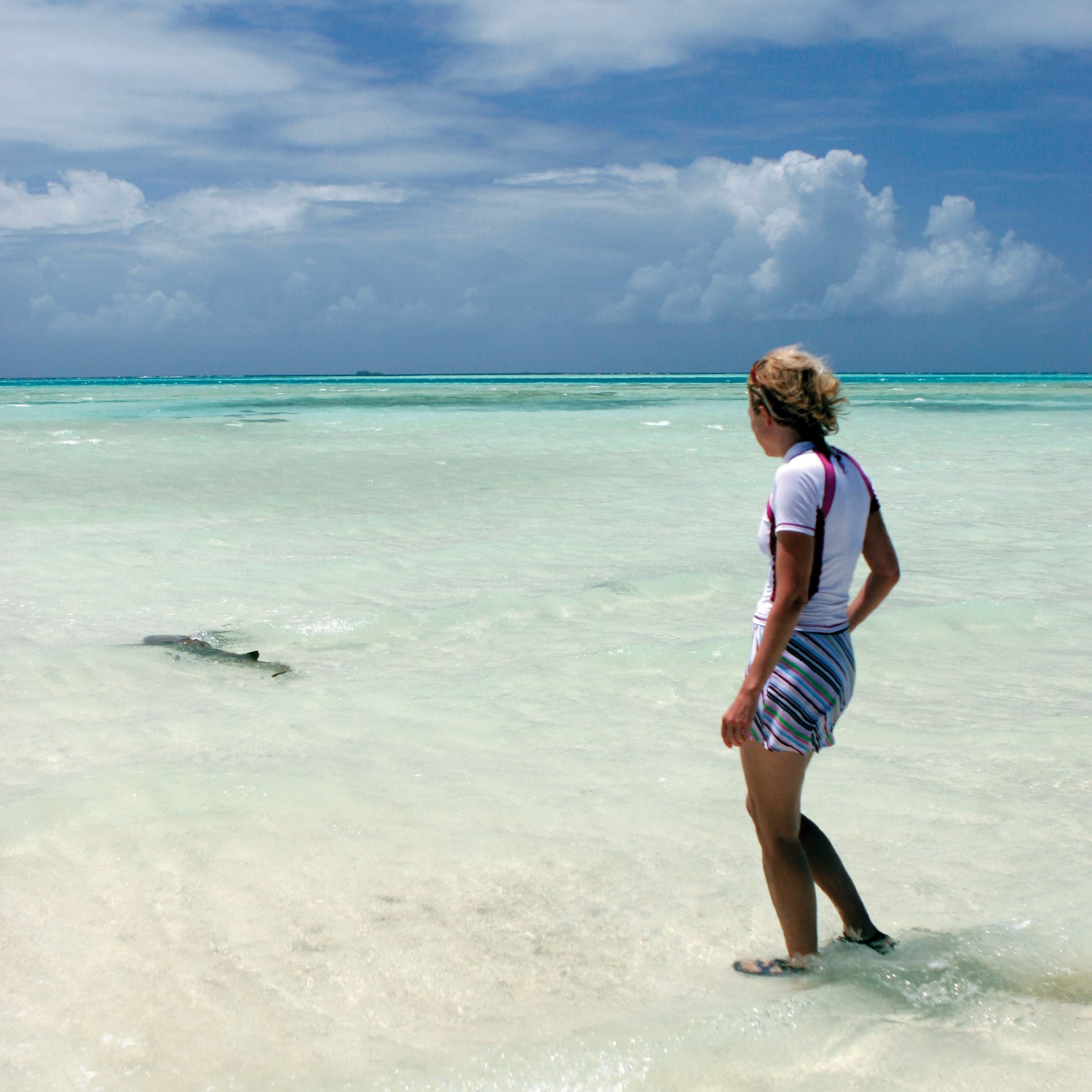“I don’t feel anything,” I say.
“Give it a couple of minutes,” says Catherine Boyd, a psychiatrist in Santa Fe, New Mexico, where I live.
A few moments later, I begin one of the wildest adventures I’ve ever taken, only this one is inside my head. I’m sitting in a reclining chair in Boyd’s office, wearing an eye mask and listening to a soothing playlist, having just been injected with my first round of ketamine, a dissociative drug that’s used for the treatment of anxiety, depression, PTSD, and addiction, among other mental health conditions.
Boyd checks in with me soon after and asks how I’m doing. I tell her that it feels like a dentist is using a Waterpik to clean out my neural pathways. Then I feel like I’m floating in a beautiful galaxy, and a stairway made of stars appears that leads up to infinity. Mostly, I see a nonsensical series of shapes and colors that look like the graphic designer Milton Glaser is doodling on the walls of my brain. It’s mind-blowing.
I’d been thinking about trying ketamine for a few reasons, one being that I was in a scary accident a couple of years ago on the way down from the local ski mountain. A large snowplow came around a corner and collided with me, totaling my car. The plow’s blade was up, and it came through the window behind me, unnervingly close to my head. I was physically shaken and bruised by the impact, and I shudder to think what might have happened if the plow had hit a second sooner.
I was so happy driving down the mountain, thinking how lucky I was to be living this outdoor life. And then: boom!
Although the accident was traumatizing, I hadn’t been able to shake off a lingering association it caused. That morning I’d been skiing with a couple of friends; it was a powder day, and I finally got the hang of how to make the turns properly. It felt so good floating on top of the snow. I had to leave sooner than my cohorts to get to work, so I drove down the mountain alone. Along the way I was so happy, thinking how lucky I was to be living this outdoor life. And then: boom!
Some might simply have been grateful that no one was seriously injured and moved on, but in my mind I connected feeling happy with getting surprised by something bad. This triggered a feeling of hypervigilance that I’d experienced growing up with a family member who struggled with substance abuse, which had made me feel on guard, waiting for the other shoe to drop. If I was always prepared for the worst, my thinking went, then it wouldn’t surprise me.
This isn’t a joyful or spontaneous way to live. I also stopped skiing in Santa Fe after the accident. I didn’t want to be on that winding mountain road again, especially after a winter storm.

“Ketamine turns off the activity of the brain’s amygdala, a part of the brain’s fear center, so traumas are more easily processed after a session,” says Boyd, who’s been administering the treatment for three years. “Many of us have built up a vase around our brains, with defense mechanisms meant to protect us that we no longer need. Ketamine allows you to safely break down that vase and build a new one that works better.”
The drug has been used in anesthesia for more than 50 years. But in a 2000 Yale University study, psychiatrists discovered that, given at lower doses, ketamine helped patients with depression. Several other studies were done over the years, including one that showed marked improvement for veterans suffering from symptoms of PTSD, and in 2019 the FDA approved use of the ketamine derivative esketamine as a nasal spray for treatment-resistant depression.
“Ketamine doesn’t work for everyone, but when it does, I’ve seen it drastically improve mood and help people reach insights they haven’t gained after many years of talk therapy,” Boyd says.
The drug is also given off-label intravenously, intramuscularly, or via lozenges. I received intramuscular injections. Each session cost $651, and the treatment typically isn’t covered by insurance.
How ketamine works is complicated. The simplified version is that the brains of some people who have experienced depression or trauma can develop faulty wiring that perpetuates their symptoms. Ketamine can repair that wiring, establishing new, healthy neural pathways.
“Ketamine affects glutamate signaling, which causes the brain to produce neural ‘fertilizers’ called BDNF—brain-derived neurotrophic factor,” Boyd says. “These fertilizers help neurons grow more connections.
“Ketamine is an opportunity to gain great insight about yourself, your past, your life,” she adds. “It doesn’t work for everyone, but when it does, I’ve seen it drastically improve mood and help people reach insights they haven’t gained after many years of talk therapy.”
For the most severely depressed people, a common course of treatment is six doses over three weeks. I wasn’t severely depressed, so Boyd and I decided to do one treatment per week, given on a Sunday, because afterward I felt woozy for an hour or so and needed to rest and be quiet.
After one of my ketamine treatments, nature’s colors popped more—the vibrant green of a tulip’s spring growth, the pink flowers of a cactus on a hike.
Even though the experience can feel like a trip, ketamine works differently than more familiar psychedelic drugs like psilocybin and LSD. While ketamine has long been abused as a street drug—often called Special K—when administered legally by a doctor, strict protocols are in place.
I went through a detailed intake process, filling out comprehensive forms on my physical and psychological health to make sure the treatment was right for me. Boyd says that people with a history of psychosis, mania, high blood pressure, and heart or liver disease should not try ketamine. Nor should pregnant women.
Boyd takes my blood pressure and oxygen saturation levels before and after each treatment—ketamine can raise blood pressure and heart rate and cause nausea—then injects a small dose to make sure I can tolerate the effects, checks in to see if I want a second dose after that, and sits with me the entire time the drug is in my system, around 40 to 60 minutes.
We also talk over how I’m doing before each treatment, and we discuss what came up for me during the session afterward. The whole process takes around two hours.
There are hundreds of ketamine clinics all over the country right now, and there’s even a way to receive the treatment online, through a company called Mind Bloom that sells and ships tablets. When I mentioned to Boyd, an avid kayaker and snowboarder, that I’d also heard of spas and nature retreats offering ketamine, she was cautious.
“Ketamine is a dissociative medication, and most people are very inward during the session,” she says. “For this reason, I would not recommend doing it in nature. Ketamine turns off the cortex and disconnects the body from the brain. It is an introspective tool for inner exploration and should be done safely in a medical setting after a person has been appropriately screened.”
There’s no way I could have been walking around outside during a treatment. I saved outdoor activities for the days after, when it felt peaceful and healing to be in natural settings and I craved quiet time to contemplate what had come up for me during a session.
As for the risks, Boyd says we’re still in “the wild west” phase, as the drug’s use for this treatment is so new. But she assured me that, at the small doses she gave me, it’s generally very safe.
It was important to me to work with a trained psychiatrist who understands neurochemistry and the brain. Boyd also strongly recommends seeing a therapist to help process any revelations. While a ketamine journey can be spectacular and beautiful, it can also bring to the surface challenging issues from your past or current life, which happened for me.
Boyd says that everyone experiences ketamine in a different way, but most people find that they connect to a sense of something greater than themselves.
A positive side effect I didn’t anticipate was that the interior awe I experienced when taking ketamine made the exterior world more vibrant, too. After one treatment, I left Boyd’s office and looked up at the mountains above Santa Fe, which had a fresh layer of snow and appeared exceptionally majestic. Nature’s colors popped more—the vibrant green of a tulip’s spring growth, the pink flowers of a cactus on a hike.
Which brings me to one of the many ketamine insights I had: there is wonder and beauty all around us, if only we’d slow down enough to see it.
Boyd says that everyone experiences ketamine in a different way, but most people find that they connect to a sense of something greater than themselves. After each treatment, I felt moments of tranquility that I hadn’t felt in years.
My ketamine journeys often brought up images of nature. One time I felt like I was sitting at the bottom of the ocean, hanging out with strands of pulsing seaweed. I also took a trip into what felt like the inside of my heart, and I was trying to open it up. Another time I struggled to identify a bizarre image that looked like a floating piece of lettuce, and my mind clearly said: Stop trying so hard to make sense of everything.
That insight helped me to begin unraveling the accident trauma. I could see that my brain wanted to assign a reason to bad things that happen, and that it was easier for me to think the universe didn’t want me to be happy than to concede that I had no control over a snowplow coming out of the blue and nearly killing me.
Challenging things are going to happen to all of us on occasion. It’s part of being a human crashing around in a busy, modern world. What we can change is our resiliency when traumatizing incidents occur. That’s where ketamine really helped. It allowed me to see trauma from a kinder, more distant perspective, and it gave me a better platform from which to process it and move forward more peacefully.
I wish I could tie this up in a neat bow and tell you that I’ve since driven up the ski mountain and felt no fear and that everything is fine again. I haven’t. The unraveling of trauma takes time.
But I can feel my hypervigilant tendencies loosening, and I’ve been seeking out more fun. I’m also more open to heading up that road than I have been in a long time. I’m tired of missing out on those powder turns.
Mary Turner is ���ܳٲ������’s deputy editor and travel director. She’s more used to physically traveling out in the world than taking a trip inside her own mind.


